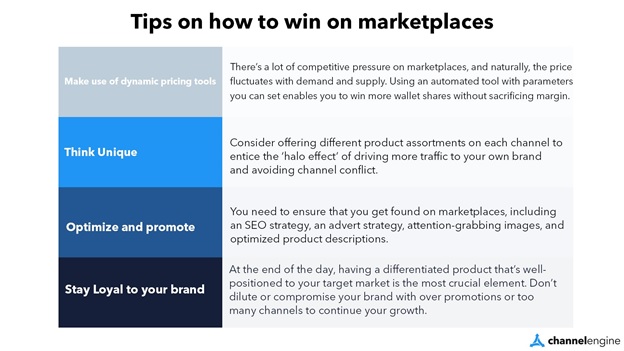Win and grow on European marketplaces
The pandemic changed everything for brands; consumers are more comfortable than ever with e-commerce, and marketplaces are taking a greater share of the total spend. Marketplaces now play a key role in the shopper journey; they create a single destination for buyers to search, filter, browse, compare, select and/or buy from multiple retailers. In this blog, we explore how your brand can take advantage of this trend: selling more by leveraging growth in marketplaces.
A broader strategy
Marketplaces offer brands and retailers an opportunity to diversify their online presence, gain new customers, and increase revenue. They can actually increase brand awareness, leading to direct customer acquisition. They can be a great way to expand into new markets. Consider the following:
- 72% of global shoppers said online shopping came to their rescue in 2020.
- According to PwC’s June 2021 Global Consumer Insights Pulse Survey this shift is here to stay.
- More than 40% of all online spending happens on marketplaces, and
- More than 60% of search queries start on a marketplace.
However, marketplaces should be considered as just one part of a wider distribution strategy. Winning a greater market share is always the goal, but your strategy needs to work for your business without eroding margins or harming customer relationships.
Consider the following questions when thinking about your marketplace strategy:
- What role does each marketplace play in my overall brand goals?
- What will you stock on each marketplace?
- How will you handle the technology? It is much easier to connect to marketplaces with a solutions provider that integrates your back-end system and connects you to multiple marketplaces.
- What ecosystem will I need? Companies like ChannelEngine offer a complete toolkit: content management, translation, taxes, and financial administration, advanced pricing and repricing tools – for each marketplace and country. But you’ll also need to consider fulfillment and logistics.
The answer to your marketplace strategy will vary widely based on your market position. For example, a luxury brand might want a more exclusive arrangement compared to a budget brand. There’s no single answer, but it’s essential to think through the details for your brand.
Local marketplaces
Consider smaller, local marketplaces or niche marketplaces as part of a selective distribution strategy. Local online marketplaces can be true heroes for building a fan-base of loyal customers. There are a few distinct benefits of working with local marketplaces as part of a channel strategy.
A lot of US and APAC brands leverage local partners and local marketplaces to start selling in Europe. With 25 official currencies and more than 200 languages, entering into European markets isn’t always easy. Each country has different rules and customer expectations, so marketplaces can make it easy to start building a brand in new markets. Look beyond Amazon, and consider your customers’ perspective.
How to win on marketplaces
On the ChannelEngine blog, we share lots of advice for performing well on the marketplaces of your choice. Here are some quick tips:
Want more advice on how to win and grow on marketplaces or help build your strategy? Don’t hesitate to contact us or request a demo.
Annabel Fay is a technology writer with a particular interest in SaaS, eCommerce, and retail technologies. Her work has appeared in Retail Week, Econsultancy, Marketing Week, Private Equity Insights, and on the blogs of her various clients, such as Adobe, Google, and Channel Engine. She’s been a full-time freelance writer for 2 years, after 10 years in eCommerce marketing.







